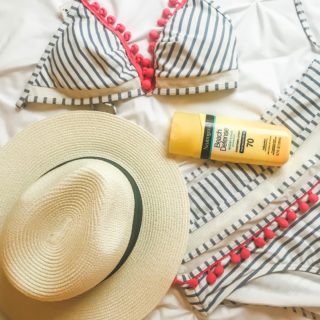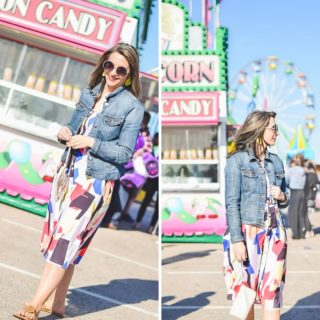It’s time again to share a DIY post. Today I’m going to share with you how to paint and reuse old cabinet hinges. A few weeks ago I shared how I painted my kitchen cabinets. It was a popular post, but it was very long! Because of that, I decided to save part of this project for a separate post.

Why I Decided to Paint the Cabinet Hinges
The process of painting and reusing old cabinet hinges is tedious and, in the end, is not going to be as effective as buying brand new hinges. If it’s in your budget and you can find hinges that will work with the holes already drilled in your cabinets, buy new hinges.
When replacing hinges in a kitchen you want to consider the color of the new cabinets (do your hinges match?) and the style of hinge. The easiest way to replace hinges is if you can find ones that work with the holes already drilled in your cabinets and with the way your cabinets doors are already set up. Look at the way your doors sit on top of the cabinets. Do you see the hinge at all? If so, do you see the entire hinge or only part of a hinge? I really like this article which describes more about the aspects I mentioned above. This website has some more helpful information about hinge types and images to describe what you should be looking for.
It may take you awhile to figure out what kind of hinge you have, but once you do – check to see if there are replacement hinges in the color you are looking for.
I did not buy new hinges because my cabinets are old and I could not, for the life of me, find the same kind of hinges in white. For that matter, I couldn’t find the same kind of hinge! It was actually quite frustrating. To get new hinges would mean having to go fill in the holes of the previous hinges, sand and paint over them. Then, I would have to redrill holes in the cabinets and the doors for the new hinge style. Since there was no way I was going to do that or to put dingy copper-ish hinges on brand new white cabinets, I decided to research the process to paint and reuse those old hinges instead.
Painting Cabinet Hinges
This post contains affiliate links, which means that if you click/make a purchase through some of these links, I will make a small commission. For more information, please see my Privacy Policy and thank you!
Materials Needed:
- Drill or Screwdriver
- Slow Cooker
- Dawn Dish Soap
- Rubber Gloves
- Tongs
- Old Toothbrush
- Medium Grit Sandpaper
- Dropcloth or large piece of cardboard
- Piece of Styrofoam
- Metal Primer
- Enamel Spray Paint
Step 1 – Remove the hinges
The first step in painting your old cabinet hinges is to remove them from the cabinets. A drill with screw attachment makes this process go very quickly. I will say that it can really help to have a second pair of hands to hold the upper doors so they don’t fall on you or rip from the cabinet while you’re getting the last screw out. Place all the screws and hinges in a plastic bag as you remove them.
Once you have removed the doors from the cabinets, remove the other half of the hinges from the doors themselves.
Step 2 – Cleaning the hinges
Now that the screws and hinges are removed, you need to clean them. If your hinges are old or have been in a place in your kitchen where they have collected grease over the years, you’re going to have to remove as much of that grease as possible. Otherwise, your paint isn’t going to stick.
To remove the grease, I placed all the hinges and screws in my slow cooker with a little bit of Dawn dish soap and added enough water to just cover the hinges. I turned it on in the morning before I went to work and they were ready when I got home from work in the evening. You could also put them in overnight. I had to do two rounds of this because I had a lot of hinges.

You would be shocked at how much gunk and grease will come off just from this step.
When you’re ready to remove the hinges, make sure to use a pair of rubber gloves and some tongs. As I removed them from the slow cooker, I used an old toothbrush to scrub particularly stubborn areas and set them on an old towel to dry. For the screws, I set them in the palm of my gloved hand and scrubbed with the brush. This helped remove old paint still stuck to the screws.
Step 3 – Sand the Screws and Hinges
Once the screws and hinges are dry, it’s time to sand them. Using medium grit sandpaper (80-120 grit), gradually sand all the screws and the hinges. This process took me quite some time. It’s hard to get into some of the hidden spots on the hinges but do your best. I often had to fold or roll the sandpaper to get into the tight spaces.

This part of the process made a HUGE difference and the difference was very visible. Afterwards, wipe off the dust from the sanding. I actually ended up rinsing the hinges because it was really hard to get all the dust off.
Lay them out to dry.
Step 4 – Prime and Paint
When they are dry, find a well-ventilated space and space the hinges out on a drop cloth or piece of cardboard. You want to have them spaced so you can spray every angle.

Push the screws into a piece of Styrofoam. For example, companies will often pack appliances with Styrofoam in the corners. Use one of those and push the screws into it so that only the head of the screw is exposed. (We had just installed some electronic door knobs so I used the Styrofoam that the knob came in.)

Now it’s time to spray a light coat of primer. I used a metal primer so that there were extra rust-inhibiting properties. It took a few light coats of primer, rotating the hinges (and sometimes bending them further open or further closed) until I got every angle. Don’t forget to spray the tops of the screws stuck into the Styrofoam too. Read the can for the proper amount of drying time.

Repeat this process: spraying, drying, rotating, spraying again, drying, rotating one more time, spraying…for both the primer and the actual paint color. I used an enamel spray paint for a nice hard finish on the hinges without the need for a clear top coat.
Step 5 – Reinstall Hinges
Once you’re sure the hinges and screws are dry, it’s time to put them back on the cabinet doors. Using the holes you should still see in the doors as guide, and your drill, screw the hinges back onto the cabinet doors.

Be sure to check to make sure you are placing the hinge going in the right direction. As I noted in the main post about painting the cabinets, I used tape to label which cabinet doors went where. At this point in the process I actually took a hinge and took a door over to where it would be installed and put the hinge on the cabinet edge and sat the door on top to make sure it was going the right direction. I quickly got the hang of it, and before long, all the hinges were back on the cabinet doors.
Finally, screw the doors back on the cabinets.
Important to Note about Painting Hinges
I will note that this was not a perfect solution for my hinges. There were a few hinges where, no matter how hard I scrubbed at the grease or how many coats of paint and primer I added, each time I would bend the hinge, it would chip off some of the paint on the moving part of the hinge. There was just no way to clean underneath that hinge so that it wouldn’t scrape the paint off when it moved. Instead, I put these hinges in the corners of the cabinets where they wouldn’t be as visible.
If spots of chipped paint are going to be a problem, and you can’t find a replacement hinge that will fill the same holes as your current cabinets, then I would recommend the longer process of changing the hinges themselves.
Please Note! If you decide to change the hinges, you will need to decide that BEFORE you paint the kitchen cabinets. You will want to fill all the holes from the old hinge screws with wood filler and sand the holes before you prime and paint the cabinets and doors. That way it will leave a smooth finish. Then, when you’re ready to reinstall the cabinet doors, you will need to measure and drill holes for the new hinge type.
And that’s it! Have you ever attempted to paint and reuse old cabinet hinges? Were you successful? I’d love to know!
Thanks for stopping by! And if you’re interested in the rest of the kitchen cabinets, make sure to check it out here!
Virginia
Linking up with: Craftastic Monday | Tips and Tutorials Link Party | Waste Not Wednesday | Sew It, Cook It, Craft It | Your Whims Wednesday | Friday at the Fire Station | Artsy-Fartsy Link Party
 Loading...
Loading...



















Wow! That’s a lot of work, but they do look really nice when completed! I’ve never attempted to paint cabinets or hardware. In our last home our cabinets were so old (1960s old) they just needed to be completely replaced. I’ll definitely keep this in mind if I want to paint any furniture though! So helpful!
Thank you! I was lucky my cabinets didn’t need to be completely replaced! But, this paint really is good. It would be great on furniture! In fact, I have a dresser I’ve been thinking of redoing and that would be a way to use my extra paint!
Wow. Painting the hinges really made a huge difference. I don’t know if I’d be that motivated, but it would look good if I were! ha. Thanks for sharing. I appreciate getting good ideas.
lol, thank you! My main motivation was to have my kitchen back. I took everything apart before I realized that I couldn’t find replacement hinges! I had to paint them just to use my kitchen again! ha!
Nice work! I have the same hinges as you and I wanted to paint them so I can save the money on replacing them. I also had the concern of the paint chipping off on where the hinges rub on each other when you open it. Alot of my hinges are old and rusty so I really hope it’ll still hold up okay after painting them. Thanks for addressing that issue and It’s a good idea to just place it in the corner where it’s not very visible. I’m wondering how your hinges are holding up about a year later since you painted them.? Thanks!
Hi Angelina, I have to say, my hinges did not all hold up as well as I had hoped. Really work hard to get the grime off before you paint them and do your best to sand as close to the hinge as possible. That’s where mine started chipping. They still look really good and the majority have held up well, but there are definitely a few (maybe 5 or so?) where the paint has chipped off the hinge part itself (rather than the plate sections that abut the actual wood).
First off I wanted to say thanks for putting this idea out there. I purchased a house and the previous owners had gold everywhere! I was hoping this trick would work for the hinges but alas, it seems that it will not. After priming and painting, upon the first move of the hinge, all the paint came off where the hinge rotates. Pretty noticeable I’m afraid. With that being said, if people are wanting a clean look then this method is probably not worth the effort.
You have the same hinges that I have! They were made by Amerock. I am having the cabinets painted, and the painters won’t install new hinges. As you know, they don’t make the exact same hinge today. The holes are different. So, it’s painting for me. Rustoleum now makes a combo primer/spray paint for metal that is amazing. I have used it on metal closet rods, and it’s held up to hangers being dragged across the rods. I’m hoping that since I am covering antique brass with brushed nickel paint, a few chips won’t be too noticeable. If they are, it’s not the end of the world. The next owner can install new cabinets!
Can you paint your hinges the with the same paint as the kitchen cabinets and not take the doors off?
Do you paint the inside of the cabinet doors?
Idk WHO would be sitting/ living INSIDE a cabinet to look at the inside/ underside of cabinet doors ALL OF THE TIME and think those areas should’ve been painted. Maybe the little fairies or gnomes from children’s story books??? 🤷🏻♀️🤣